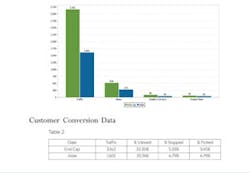Recent findings of European and U.S. surveys conducted in the retail industry reveal that while retailers are aware of the security benefits of network video surveillance, a greater understanding of the operational benefits is still needed. By taking advantage of a large variety of intelligent applications compatible with network cameras, retailers can benefit from more than just security, including insight into customers' behavior that help design better shopping experiences.
The "Surveillance Survey Report," sponsored by Axis Communications and conducted by the Loss Prevention Research Council (LPRC), states that 87 percent of retail companies that currently use analog technology for surveillance are now considering migration strategies toward network video.
Survey results are positive for analytics
Results based from four different studies (targeted at security managers, loss prevention executives and CEOs at retail companies) show that the most known intelligent applications available for network surveillance are people counting and queue counting, averaging 67 percent of survey respondents across the U.S. and Europe who are aware of these. Majority of respondents are also interested in applications for hot/cold mapping, also known as "zone mapping," which occurs when a camera with embedded intelligence measures the number of people spending time in certain areas of a store and, in essence, the store as a whole. The result is a "heat map" which shows the areas where people spend the most time as well as the routes that are most commonly taken by customers around the store. These patterns are shown by different colors (see image). Zone mapping helps retailers make informed decisions on how to lay out the store.
Questions retailers are asking?
Retailers understand the innovations, intelligence and usability of IP, and are now asking, "How can we use network video for more than just surveillance?"Questions are focused on integration with existing retail systems, such as point of sales (POS) systems and procedures.
In the past the only way to collect useful data about customers' behavior and movements was via expensive and cumbersome manual processes. Things changed with the advent of IP-enabled cameras embedded with intelligent video analytics. Now, it is possible for retailers-or any type of end-user-to access data in real time and link it to actual sales and operations. This information can then be used when making decisions about store design, analyzing store layouts and for maximizing in-store real estate such as fixtures and signage. Retailers are then able to test these strategic decisions to determine how well they perform, which completely transforms the way business is done. From a customer perspective, entering stores that are well designed with product placement in mind based on customer behavior will improve the shopping experience, making it easier to find the things they want to buy.
Hot retail applications
There are two ways retailers are using video today. The first is as a surveillance tool to fight crime and prevent fraud, and the second is the use of network cameras to support marketing, operations and merchandising efforts. Not only are the cameras useful for analyzing customers' behavior, they can also serve as an extra pair of eyes, alerting store managers when long queues are forming at cash registers so that they can allocate their staff accordingly. Of course, while the camera is assisting marketing and operations, it is always an extra eye for the security guys.
One other challenge that retailers face is being able to identify when something-good or bad-is about to happen. One common way to determine this is to use dwell time analysis to see how long an individual spends in a certain area or in front of a product display. The person might be planning to steal an item or they may simple need some help from a member of staff. Dwell time analysis can help prevent theft as well as improve customer service.
The whole industry must work at developing the best solution for all end users, not just retailers. We need to take advantage of the evolving technology not only in terms of intelligent applications but also the cameras themselves. With the introduction of the ONVIF standard, backed by the majority of IP network camera vendors as well as software vendors, we are making it even easier to combine bits and pieces to build an open system. Using open standards makes it easy to integrate with existing systems, thereby widening the range of solutions available to the end-user.
Other interesting video surveillance trends within the "Surveillance Survey Report" study include:
- 98 percent say that video surveillance reduced internal loss (employee theft, etc.)
- Nearly 75 percent claim that video surveillance reduced external loss (shoplifting, return fraud, etc.)
- Of the respondents who indicated that poor image quality was one of the top four negative effects of video surveillance,100 percent of them had analog technology as part of their system.
- People counting is the most widely deployed non-LP analytic application, with 27 percent of responders currently running the application in store.
- Hot/Cold Zones (13 percent), Dwell Time (13 percent) and Queue Counters (10 percent) were other additional applications used by retailers today, with more than half of the respondents indicating that they would use these applications in the future if they are not today.
Note: Featured results are from four different surveys, (conducted between August 2009 and October 2010), sponsored by Axis Communications and conducted by the Swedish Trade Federation Svensk Handel (Sweden); IDC Retail Insights (Italy); the Center for Retail Research (UK); and the Loss Prevention Research Council (LPRC).
Johan Akesson is the director of Business Development, Retail, for Axis Communications.

